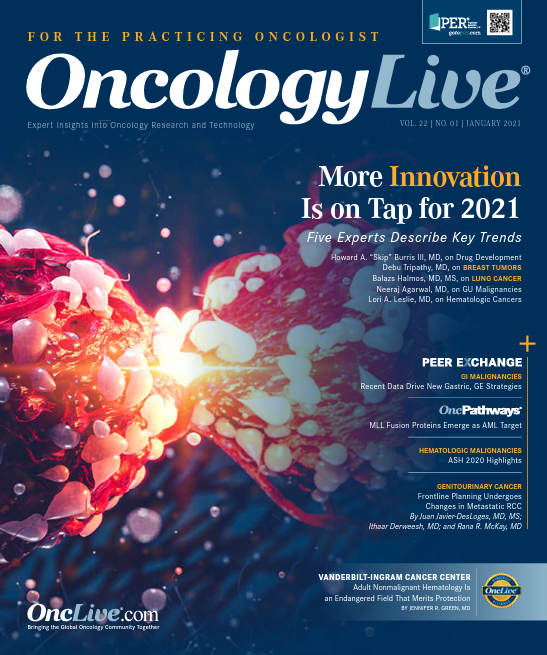First BCMA-Targeting Therapy Debuts in Multiple Myeloma
Sagar Lonial, MD, discussed key facets of belantamab mafodotin and potential next steps.
Sagar Lonial, MD

The approval of belantamab mafodotin-blmf (Blenrep) for patients with refractory multiple myeloma marks the first therapy directed at B-cell maturation antigen (BCMA), a target of robust research interest, to reach clinical practice. The FDA granted an accelerated approval for the agent on August 5, 2020, for adults with relapsed or refractory multiple myeloma who have received at least 4 prior therapies, including an anti-CD38 monoclonal antibody, a proteasome inhibitor, and an immunomodulatory agent.1
The decision was based on findings from the ongoing phase 2 DREAMM-2 study (NCT03525678), which tested 2 dosing levels of belantamab mafodotin in patients who were heavily pretreated. The approval stemmed from an overall response rate (ORR) of 31% (97.5% CI, 21%-43%) among 97 patients who received the recommended dose of 2.5 mg/kg administered intravenously once every 3 weeks. Responses persisted for 6 months or longer in 73% of responders.1
After 13 months of follow-up, responses rates were similar regardless of the number of prior lines of therapy that participants had received, according to findings from a post hoc analysis presented at the virtual 62nd American Society of Hematology Annual Meeting and Exposition in December 2020 (ASH 2020). For those who had received 3 to 6 lines of prior therapy, the ORR was 34% with a median duration of response of 11.0 months (95% CI, 4.2-not reached [NR]), and the median overall survival was 13.7 months (95% CI, 9.1-NR). For patients who had 7 or more previous treatments, the ORR was 30% with a median response duration of 13.1 months (95% CI, 4.0-NR), and median overall survival of 13.4 months (95% CI, 8.7-NR).2
Belantamab mafodotin, which is an antibody-drug conjugate, “represents a useful treatment option for relapsed/refractory multiple myeloma, including patients with a high burden of prior treatment for whom prognosis is otherwise poor,” Sagar Lonial, MD, the lead investigator in the DREAMM-2 study, said in presenting the updated data at ASH 2020. Such patients, Lonial said, typically experience a decrease in the depth of response and shorter remissions as they undergo successive lines of therapy.
Lonial, a 2020 Giants of Cancer Care® award winner, is chief medical officer at Winship Cancer Institute of Emory University in Atlanta, Georgia. He also is professor and chair of the Department of Hematology and Medical Oncology and the Anne and Bernard Gray Family Chair in Cancer, both at Emory University School of Medicine. In an interview with OncologyLive®, Lonial discussed key facets of belantamab mafodotin and potential next steps.
Some investigators have said that successful targeting of BCMA would be a transformative development for multiple myeloma therapy. Would you agree?
Yes. I think the advantage that BCMA has over, for instance, CD38, or even SLAMF7 is that the target is expressed much more exclusively on plasma cells, so the off-target impact is going to be less. Signaling through BCMA is 1 of the reasons multiple myeloma cells proliferate and are drug resistant. Blocking BCMA not only targets the tumor cell, but it also may help to overcome drug resistance.
Please describe the patient population for this drug.
The FDA approval is for patients who are triple-class refractory, so [the patient ideally would be] resistant to proteasome inhibitors, immunomodulatory drugs, and anti-CD38 antibodies. For me, it would be a patient who has had 3 prior lines of therapy and still has a reasonable performance status to get any treatment at all. My go-to in that situation, if not a clinical trial, would be belantamab mafodotin.
Belantamab mafodotin was approved with a boxed warning about the risk of ocular toxicity. Could you discuss this adverse event?
The ocular toxicity is somewhat unique for myeloma drugs. It is more of an exam finding by an ophthalmologist or an optometrist; it does not always result in significant symptoms. In fact, only in 18% to 20% of the time [does it actually result] in change in visual acuity.
I think the take-home messages are that [the agent] is a really good option for triple-class refractory myeloma and, importantly, partnering with an eye care professional is part of the process. It’s something we should get used to doing in order to figure out how to maximize the benefit from belantamab.
The best way to treat [an ocular effect] is to hold the drug and let the patient recover from the toxicity. What I think is important and different from many other drugs, though, is that the half-life of belantamab mafodotin is long enough that even if you have to hold a dose or 2 for 3 weeks, or oftentimes 6 weeks, most patients still maintain or improve their response. So, it’s not as though if you don’t stay on schedule you’re going to be in trouble.
Are there immunogenic qualities to belantamab mafodotin?
Yes, it does induce immunogenic cell death. As such, it’s being tested right now in partnership with for instance, pembrolizumab [Keytruda; DREAMM-4; (NCT03848845)] to see whether that immunogenic cell death in combination with a checkpoint inhibitor may activate an innate T-cell response separate from the effect directly of the development.
What are some unanswered questions about this drug?
I think the question is going to be, how do you partner [BCMA-targeting agents] with other drugs? Those trials are being done now, combining it with pomalidomide [Pomalyst], with bortezomib [Velcade], with lenalidomide [Revlimid]. How you sequence [the drugs] is another question that’s coming up. If you’ve had 1 [anti-BCMA drug], can you respond to another?
That’s a question we’ve not been able to answer because most of the trials have excluded prior exposure to BCMA. But now they’re including cohorts of prior BCMA therapy. So I think we’ll get an answer to that question in the next year.
References
- FDA granted accelerated approval to belantamab mafodotin-blmf for multiple myeloma. FDA. Updated August 6, 2020. Accessed December 13, 2020. https://bit.ly/2J4MdIO
- Lonial S, Lee HC, Badros AZ, et al. DREAMM-2: single-agent belantamab mafodotin (Belamaf) in patients with relapsed/refractory multiple myeloma (RRMM)–1-year outcomes by prior therapies. Presented at: 2020 ASH Annual Meeting; December 5-8, 2020. Abstract 1417. https://ash.confex.com/ash/2020/ webprogram/Paper137693.html




